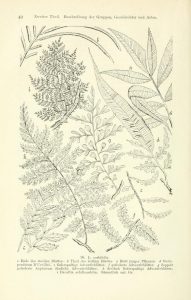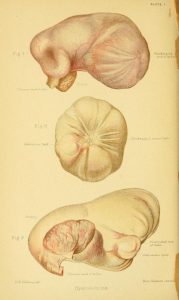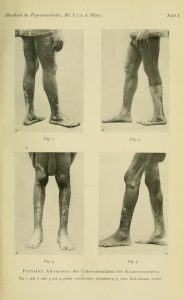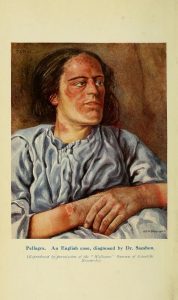The Medical Heritage Library and its digitizing partners exist to promote and provide access to resources in the history of medicine. That history says much about who we are today—about how we practice medicine, about how we view the body, about the nature of embodied experience and what it means to be? Rare books and journals, but also more ephemeral items like pamphlets and even films are made available to the public without cost. But why digitize these items at all? Why not just leave them in the libraries of which they are a part? I’ve heard the question asked in a variety of ways and in different venues; frequently, it’s a well-meaning query about the value of brick-and-mortar institutions. And, as someone who works for such an institution, I can understand the sentiment. Even so, there are excellent reasons for digitizing our collections—and for doing it right now.
As Research Associate and Guest Curator, I spend every day surrounded by unique and hard to access historical material. The Dittrick Medical History Center and Museum, located in Cleveland, Ohio, has over 150,000 artifacts, an incredible rare book collection, and affiliation with both a medical library and a university library. When I teach the history of anatomy, I go to the Stecher Room and fetch Vesalius, or to the stacks downstairs and retrieve Gautier. When researching the history of reproduction for an exhibit, I can easily access and peruse William Hunter’s Gravid Uterus. I have, at my fingertips, a world of ideas. But it was not always so.
A few years ago, I took a position at a small university in Minnesota. One of the first hurdles I encountered as an eighteenth century historian of literature and medicine was a lack of primary sources. In the midst of turning dissertation chapters into articles, I suddenly found repeated and seemingly insurmountable obstacles between me and my sources, not just in retrieving them, but even in the search for them. My PhD had been built around those sources, and around the search engines of databases like Eighteenth Century Collections Online and for the first time I realized the apparent desert that existed beyond my alma mater’s generous holdings. In this, I was not alone.
Many researchers find themselves seriously handicapped by issues of accessibility. They struggle to surmount these difficulties in a variety of ways, including travel to other collections. I was, in fact, encouraged to do so by my institution—and yet, like many researchers, scholars, and even tenure-track faculty, I found the monetary resources very thin for such activities. Why not apply for travel funds from the libraries and collections themselves? I was lucky in receiving several travel grants, including one from the Bakken Museum and one from the College of Physicians of Philadelphia (both contributing partners to the MHL). Yet, library collections are also under pressure financially; not every important collections can support researchers—and those that do cannot support all who apply. As academics, librarians, and curators, we pride ourselves on avenues of access, on the free circulation of information, on the democratic ability for all people to engage with history, especially the history of medicine. In practice, however, such things are more and more difficult to achieve. As a scholar, I had to rely on what I could find online in (usually frustrating) digitized book searches. Discovering the Internet Archive smoothed the way for continued research, and the Medical Heritage Library further supports this mission by specifically providing many thousands of works specifically in medical history. Why digitize collections? Because this is our medical heritage—and the digital is sometimes the only means of sharing it.
Let’s return, though, to the second question: why now? There is an urgency to these projects that many recognize, but fewer understand. Digitization, though sometimes perceived as a threat to existing collections, may also be the best means of saving them. The most obvious way this occurs is through the careful cataloguing, in print and image, of fragile history. There’s only so much we can do to preserve our collections; some have survived thousands of years, but the reality is that they will continue to degrade, to fade, to become unreadable. In my office at the Culture, Medicine, and Psychiatry journal, we have a pair of brilliant black-and-white photos. They depict the inside of an excavation in Egypt, where columns are bright with art work. Those columns are now empty, blank, worn away by sand and wind that entered after opening the tomb. These photos are all that remain—and so it may be with some of our treasured artifacts today. Arguments abound that, of course, even the digital will degrade, and probably faster. It’s true, but the digital also provides us the opportunity to do something more: to disseminate.
People cannot come to a library or museum if they never hear about it’ existence. The Dittrick Museum is no exception. We have been called a “hidden gem” and a “best kept secret” in our own community. To raise awareness, we’ve been hosting events, inviting classes to join us, and renovating for a more user-friendly experience. But we’ve been working on the digital, too. Our archivist and photographer are working to add our collection to a searchable system, and I—with chief curator James Edmonson—have begun the grant-writing process for an ambitious digitization of artifact and story for an interactive display. Other museums and libraries are doing the same (the Wellcome Library and Collection is an excellent example—and not surprisingly, also a principal MHL contributor). By sharing our collections digitally we reach a larger audience. We attract new visitors. We build a community of like-minded people, of scholars and researchers and curious minds young and old. In a time of tight budgets, it’s ever more important to help the wider world see and understand the relevance of libraries and other collections. In sharing this history, as the Medical Heritage Library and partners have done, we also provide the means of preserving it.









